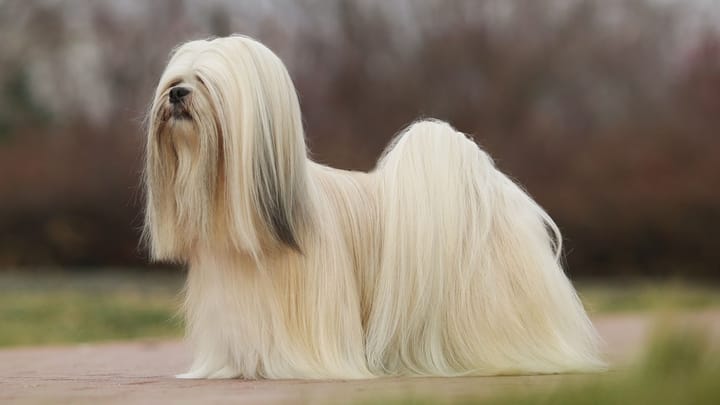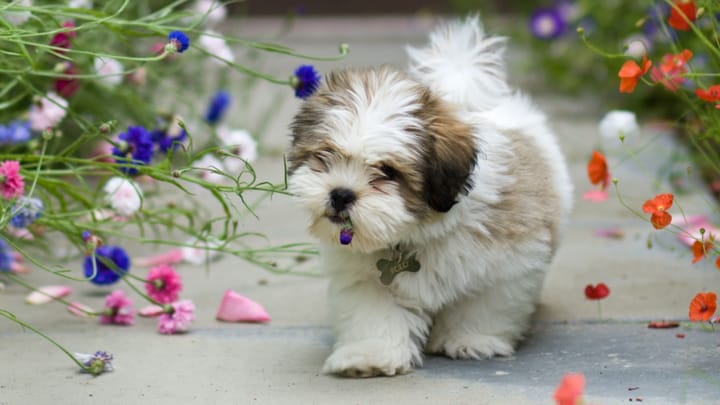Lhasa Apso


The Lhasa apso is a small non-sporting dog which, on account of his sensitivity, solid constitution and good nature, is a very pleasant companion animal that will appeal to many types of owners. His cheerful and playful personality makes him a great friend to children, and his calm character renders him a suitable companion to the elderly as well.
|
Life expectancy |
The Lhasa Apso has a life expectancy of between 14 and 18 years |
|
Temperament |
|
|
Size |
Small
|
|
Adult size |
Female
Between 7 and 11 in
Male
Between 8 and 12 in
|
|
Adult weight |
Female
Between 9 and 13 lb
Male
Between 11 and 15 lb
|
|
Coat colour
The coat can be golden, honey, sand, dark grey, slate grey, black brindle, white or brown. The Lhasa Apso can also be parti-coloured (several distinct colours at once). |
Black White Brown Blue Sand |
|
Type of coat
The coat is long. The Lhasa Apso’s coat is double: an abundant topcoat that is straight, relatively coarse, neither wooly nor silky, and quite lengthy; and a thick undercoat that renders him generally resilient. |
Long Hard |
|
Eye colour
The eyes are dark. |
Brown
|
|
Purchase price |
The Lhasa Apso costs between £480 and £600 |
In Tibet, many of the Lhasa Apsos live at high altitudes, often in very harsh weather conditions, which is where he gets his robustness from. This resilience has had a significant impact on his evolution since his coat has adapted according to the harsh climate in which he has evolved: his coat has insulates him in the winter, and his pretty fringe protects his eyes (from the wind and dust among other things).
More details about the Lhasa Apso
Lhasa Apso: Origins and history
The breed has evolved within buddhist monasteries and villages located around the sacred town of Lhasa. The Lhasa is very old and only spread to Europe quite recently (the 20’s in the case of England), but has enjoyed instant popularity. It is the result of a cross between the Tibetan Terrier and the Tibetan Spaniel. The Chinese considered it to be a ‘lucky charm’ dog and he was even nicknamed the ‘talisman dog’ when he first arrived in Europe. The first Lhasa Apso Club in England was established in 1933. The breed was then associated to the Terrier category, but the American Kennel Club removed it from the working dog group and cemented its classification as a companion dog in 1955.
Physical characteristics of the Lhasa Apso
The Lhasa Apso is a little dog with an oblong frame, low and stocky, but agile nevertheless. The head is quite imposing, with a luscious cascade of hair over the eyes, a voluminous beard and a moustache. The skull, quite narrow, delicately tapers in behind the eyes. The eyes are medium-sized, neither bulgy nor beady. The pendant ears sport a heavy fringe. The body’s length is greater than the shoulder height. The tail sports a long fringe as well, and is curled over the back. He often has a knot (bone thickening) at the bottom of his limbs. The limbs are short, straight, profusely covered in hair, and stocky.
FCI classification of the Lhasa Apso
-
Group 9 - Companion and Toy Dogs
-
Section 5 : Tibetan breeds
Lhasa Apso: Characteristics
Lhasa Apso: Behaviour
Training a Lhasa Apso
Sensitive, intelligent yet at times somewhat of a scatterbrain, this little Tibetan dog needs structure. Some rules of life must be implemented as soon as the Lhasa Apso integrates the home, to prevent him from developing any bad habits.
One does tend to be somewhat lenient towards little dogs on account of their size. But these dogs need just as much firm and coherent discipline as their bigger peers!
All aspects of training must be initiated quite early on with this dog, and if the sessions are short but regular, the basics of discipline will quickly be absorbed. Consistency and coherence are key in obtaining optimal results from this dog.
Lhasa Apso: Lifestyle
Breed compatibility Lhasa Apso
Lhasa Apso: Purchase price
The price of a Lhasa Apso varies depending on its origins, age, and sex. You have to count an average of £600 for dogs registered at the Kennel Club.
With regards to the monthly budget required to meet this dog’s needs- including quality nutrition and basic care (deworming, vaccines, grooming, etc.)- you have to estimate an average of £30 per month.
Lhasa Apso: Shedding
Average
Hair loss is moderate but more pronounced during both yearly moulting seasons (autumn and spring), when maintenance will have to be even more scrupulous in order to remove all residual dead hairs.
Lhasa Apso: Grooming
This little companion dog’s abundant coat does require diligent, daily care and regular baths (usually once a month).
His hair needs to be detangled every week, and brushed every day to preserve the coat’s beauty and protective properties.
His folded ears also require attention- more specifically, they need to be checked and cleaned regularly.
Lhasa Apso: Health
Life expectancy is 16 years on average.
He is very robust and capable of braving the coldest weather, thanks to his abundant coat. In addition to this, he usually enjoys a very long life.
Of a solid constitution, he is robust and can by all means handle periods of intense heat, but must have endless supplies of fresh water and a resting spot in the shade at his disposition.
His abundant coat insulates and allows him to tolerate bad weather and the cold, but he nevertheless prefers all of the comforts of indoor living during wintertime.
Snacks and leftovers in between meals must be limited in order to protect this little pooch from any health issues- he is indeed robust, but remains sensitive too.
- Progressive retinal atrophy
- Congenital hydrocephalus
- Entropion







